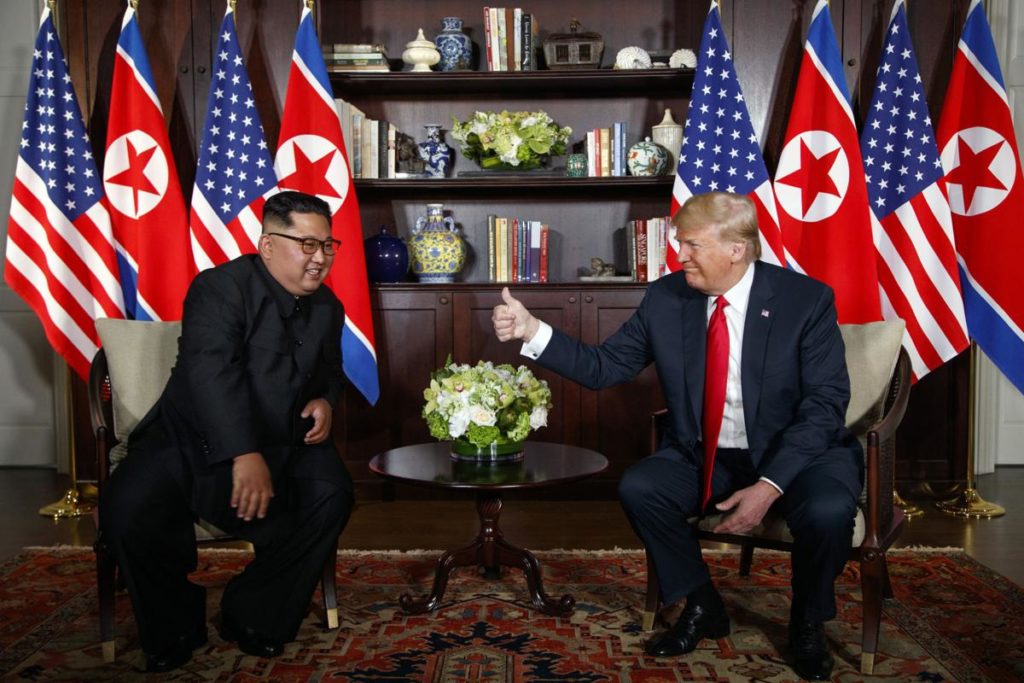As the world waited, Donald Trump and Kim Jong Un sat by themselves for the better part of an hour, alone but for a pair of interpreters who became the sole witnesses to history’s first face-to-face conversation between an American president and a North Korean leader.
The scores of aides, bodyguards and diplomats who accompanied the leaders from Washington and Pyongyang waited elsewhere for the roughly 40-minute one-on-one meeting in Singapore. To some national security veterans, it raised concerns about the risk of holding such a monumental meeting solo.
If there was any tension between Trump and Kim, they did not show it as they emerged from their seclusion and proceeded to a second meeting and working lunch — this time joined by a larger coterie of aides.
“Very, very good,” Trump told a waiting cadre of reporters, adding that the two were forging an “excellent relationship.”
Still, word that the two planned a private tete-a-tete had unleashed a torrent of criticism on social media even before the summit began. After all, having aides present in high-stakes meetings — especially ones with adversaries like the leader of North Korea — provides a president with a modicum of protection, ensuring there are staffers on hand to take accurate notes.
Absent a detailed historical record and corroborating witnesses, the president’s interlocutor could potentially leave the meeting and misrepresent what transpired, creating a he-said-he-said showdown that could turn into a major headache for the U.S. leader.
“Bad idea,” tweeted Paul Haenle, a former China director at the White House National Security Council in the Obama and George W. Bush administrations. “I could see Trump giving up a lot for very little in return.”
Barry McCaffrey, a retired U.S. Army general, called the one-on-one meeting an “unacceptable danger to U.S. national security.” He took to Twitter to say that Secretary of State Mike Pompeo and Defense Secretary Jim Mattis should oppose the meeting “in writing.”
“NSC should have TRANSCRIPT of all interactions with brutal, nuclear armed dictator,” McCaffrey wrote, referring to the National Security Council. At stake, he said: “America’s security.”
Translating for Trump in the one-on-one meeting was Dr. Yun-hyang Lee, ?the U.S. State Department’s division chief for interpreting services. North Korea did not immediately disclose the identity of Kim’s interpreter.
Yet despite the apprehension, there is established precedent for presidents meeting privately with foreign leaders — including foes — with only interpreters as witness. Note-takers are not essential: In the past, interpreters have fulfilled that role by drawing on their contemporaneous notes to provide an official, historic record.
Former President Barack Obama was known to occasionally hold impromptu chats with leaders on the sidelines of major global summits with only their interpreters at their sides. Early in Trump’s presidency, he raised eyebrows when he met with Russian President Vladimir Putin during a conference in Germany with only a Kremlin interpreter present.
At former President Ronald Reagan’s first meeting with then-Soviet leader Mikhail Gorbachev in Geneva, Switzerland, in November 1985, the two men met alone with only trusted interpreters. Only 15 minutes had been allotted for the discussion, but it went on for a full hour.
What’s more, the official U.S. “memorandum of conversation,” or “MemCom,” of that meeting was written by the longtime U.S. Russian-to-English interpreter Dmitri Zarechnak, according to a copy of the document posted by the National Security Archive at The George Washington University. The MemCom identifies Reagan and Gorbachev and their interpreters, Zarechnak and Yuri Uspensky, as the only participants.
(AP)











